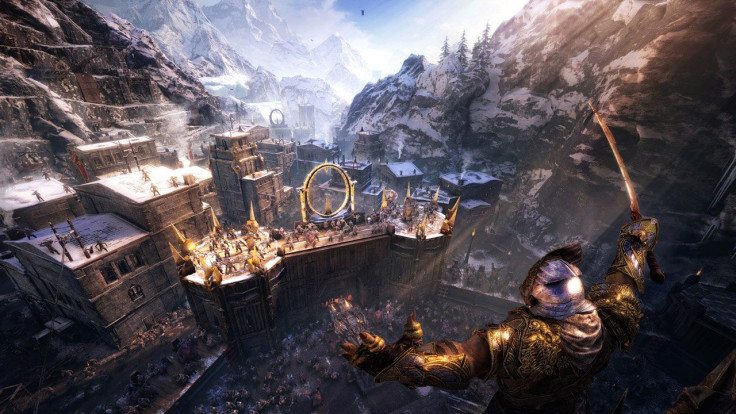There weren’t many games I was more excited about during the build-up to E3 2017 than Middle-earth: Shadow of War. I was a huge fan of its predecessor, Shadow of Mordor, and finished the game a second time earlier this year out of sheer excitement for the sequel. But my time with Shadow of War was frustrating and I’m definitely hoping a few rough edges are sanded down before the Shadow of Mordor sequel hits PC and consoles in October.
My demo focused on a fortress siege, like most of the early promotional media for the game, and gave me a chance to both plan and carry out the invasion. The Nemesis and Army systems are both very different beasts in Shadow of War and that’s apparent from the planning screen onward. Talion can choose a personal bodyguard from the orc chieftains he’s already branded and spend a new currency on modifiers for the platoons assigned to each of the Bright Lord’s lieutenants. You’ll also get a rundown of the strengths, weaknesses and unique modifiers of the keep’s overlord, powerful orcs who’ve fought to claim and defend their thrones. It’s important to spend a few moments before each siege analyzing the strengths of weakness of the occupying force. Those who rush in without a plan will find quick deaths waiting on the battlefield. Some keeps have stronger walls that are tough to breach without sappers or siege weaponry. And the obstacles waiting inside the keep are even more dangerous.
Taking a fort is a multi-stage process. Once you’ve planned the assault, it’s time to breach the outer wall, a process that occasionally involves dodging vats of poisonous liquid or incoming projectiles. Your army will clash with the overlord’s while an entrance is located. Sometimes it’s just a matter of waiting for your sappers to breach the gates. Others will call for much larger solutions, like graugs or siege weapons. Once inside, it’s up to Talion claim all three victory points in the keep. After the exterior forces have been mopped up, it’s time for the Bright Lord to enter the overlord’s inner sanctum and depose the keep’s leader. But it won’t be easy.
Each overlord is a powerful member of Sauron’s army. Many have slain enough of their brethren to become local legends. And this is reflected in both their skillsets and armament. Overlords tend to be well-equipped, with few easy-to-exploit weaknesses, and also tend to have their own team of bodyguards. In fact, the warlord I’d been asked to defeat in my own demo was immune to arrows, enraged by Frost — Shadow of War’s elemental replacement for the stun attack mapped to B in Shadow of Mordor — and he wasn’t susceptible to head-on combo attacks either. To make matters worse, I hadn’t slotted any poison skills for Talion, leaving me unable to take advantage of the overlord’s only weakness. As you probably expected, the fight didn’t go my way.
Fortunately, the world doesn’t reset after Talion falls in battle. Any warchiefs you slaughtered during the initial invasion remain dead when Talion is revived; however, the same can be said for all of the Bright Lords warriors, too. If you managed to clear a path all the way to the throne room, Talion can charge back in give it another go. But it’s probably best to adjust your skills — which might mean leaving for a few minutes to earn more skill points — before diving back in.
It’s a great evolution of the Nemesis system; one that certainly beats chasing down warchiefs in the middle of random clearings or settlements to brand or execute them. But I wasn’t a fan of all the new content being shown at E3 2017. The expanded loot system isn’t really what I was looking for in a Shadow of Mordor sequel. Sure, it’s nice to be rewarded when Talion pulls off something particularly great, like claiming a fortress for his army. But now there’s tiered loot for five different equipment slots and each piece can be further upgraded in combat. Maybe it’s just me, but Shadow of War is one of those games where I don’t want my ability to progress to be tied to random number generation. Less importantly, I’ve also never been a fan of the way the Middle-earth series highlights loot — with glowing runes that float in mid-air — and I’m really not looking forward to having even more clutter on-screen during tense fights.
The controls in my Middle-earth: Shadow of War demo also felt a bit sluggish and unresponsive. I was among the first 20 or so people to get hands-on time with the game, so it’s unlikely that a heavily-used controller was to blame, but I’m definitely hoping combat feels a bit better when Shadow of War charges onto PC and consoles in October. I’m also not sure how I feel about the new combo meter. I still don’t fully understand all of the changes. But the number of hits delivered isn’t the only metric to watch now. Sometimes five hits will be enough to perform an execution. Sometimes you’ll need 10+. I’m sure it will be explained better in the final game. But that confusion led to a fair amount of frustration during my demo.
It’s still not clear how much of the Shadow of War experience centers around the invasion mechanics. Monolith isn’t talking about the game’s map size or the number of keeps that will be scattered across it when Shadow of War debuts later this year. But with a few tweaks, I suspect fortress assaults will be one of the most popular activities in the upcoming sequel.
For an early look at Middle-earth: Shadow of War, set aside some time to watch the gameplay preview that aired earlier this week. Then head down to the comments section and let us know if you’re planning to check out Shadow of War when the game hits PC and consoles this fall.
Middle-earth: Shadow of War is in development for PlayStation 4, Xbox One and PC. The game debuts Oct. 10.
Be sure to check back with Player.One and follow Scott on Twitter for additional Middle-earth: Shadow of War news in 2017 and however long Monolith supports Shadow of War after launch.


















